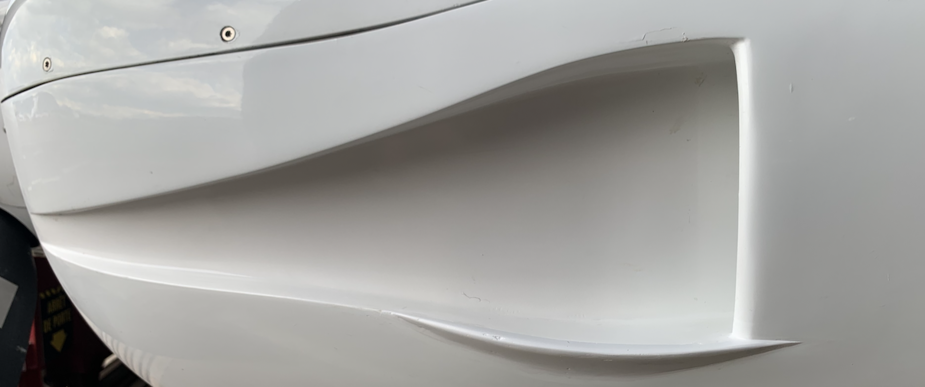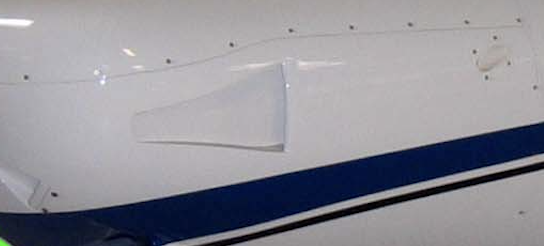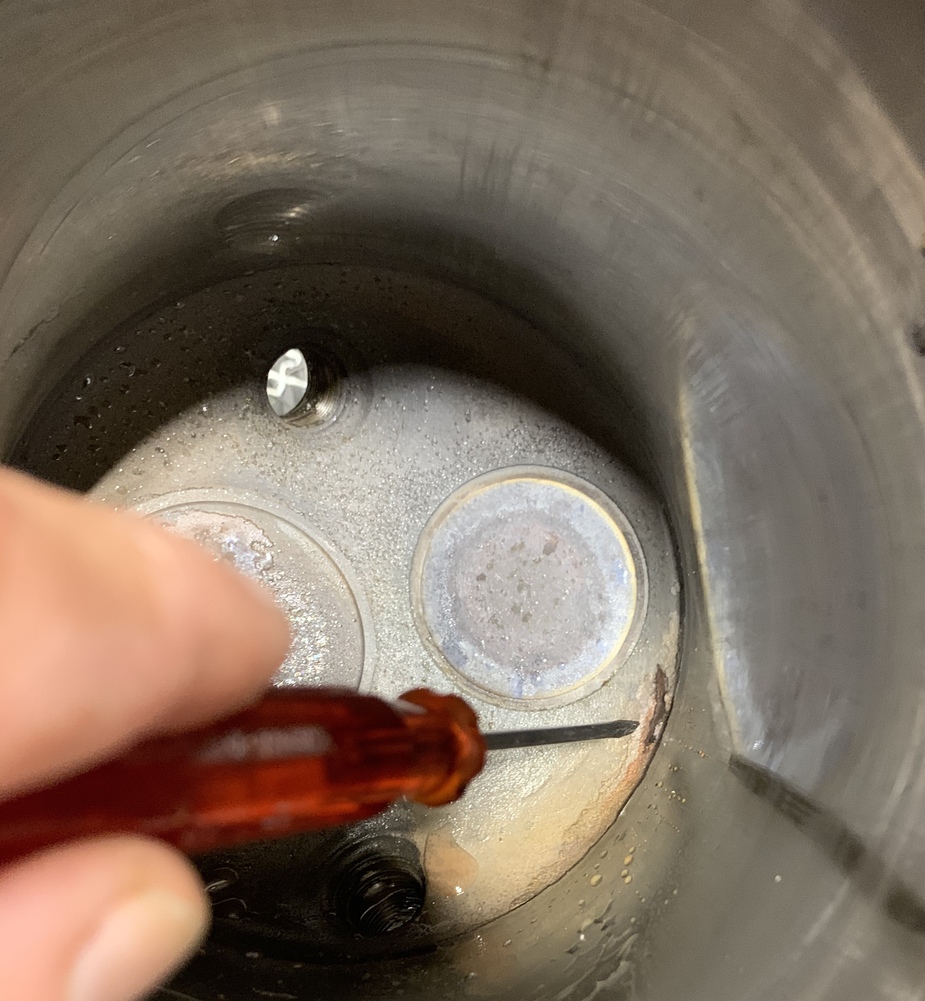I need our aerodynamics experts’ opinion here! Something weird and positive happened.
I have made a minor change to this air inlet.
Notice the lip on the lower side? According to the NACA design data this is supposed to increase pressure recovery of the inlet.
I was expecting a possible minor negative impact on cruise speed due to more mass flow in the intercooler.
Turned out to be the opposite: I saw a speed increase – 2 unexplained knots.
It was ISA + 9 at my cruise altitude of FL190 yesterday and I saw the following numbers in Eco cruise at 72 liters per hour
Indicated airspeed 143 (3 knots more than usual)
True airspeed 192-193 (about 4 knots more, of which part can be explained by the higher than ISA density altitude)
I was light on this flight but from experience 200 Kg less weight = 1 knot of speed, and I saw 3 or 4…
Where does the rest come from?!?

No idea about your question, but it made me realise the E400 has 7 (!) air intakes at the front, what does this particular intake do?
Actually 5 inlets and 4 outlets @denopa.
This intake is the intercooler’s, on the left side. The one I’m trying to improve.
Funny enough, my aircraft which has serial number 03 is the only one that has such refined NACA inlets.
Extra switched to much simpler inlets with a steeper ramp for the following aircraft.

I suspect that this was a simplification and cost cutting measure – how do you detach these huge and complex NACA’s from the mold of the lower cowl??
More news! the bad first:
After taking us to Sicily in September 2020 then to the Greek isles in October, beating hostile weather and making a nighttime Alps crossing in IMC above FL200, Galatea was in the shop for a well deserved 100 hour rest.
I noticed a slight drop in coolant level, looked for visible leaks and found none. On the ground, the coolant circuit pressurised OK, but we found a few droplets of water in the oil…
I proposed a borescope inspection and sure enough, when removing the lower plug on #2 it peed on me!
Pulled out the cylinder and found a crack in the aluminum head.
This is annoying, but not unexpected. These cylinders have delivered flawless performance so far, and after 600 hours, I am willing to accept one cracked head – knowing that these are sand cast and known for lousy metallurgy…
But when sh*t happens, it picks the right place: cylinder 2 has the following neighbours which all had to be removed first:
- turbo
- wastegate
- exhaust end pipe
- coolant take
- oil neck
- LH mag and harness
- Prop governor control…
Sheesh… that was a rough day – but hey, now we can repaint all of the parts that looked tired, repair the exhaust shield -again – and the engine will look great!
Plus I’ll be in for 25 hours of 75% power break-in. The nice thing about this. is the speed! 205 KTAS at FL180 is an expensive but very satisfying lifestyle.
Now here the good – great- news. We of course borescoped all other cylinders. They all look so great that my mechanics were very impressed. After 600 hours, there were hardly any stains on the pistons, it was easy to read their SNs and the nickel-plated RAM barrels were spotless. All exhaust valves showed minimal and symmetrical colour patterns and we were really very happy. the cylinder we removed also looked great but for the crack btw…
Why is this great news? well keep in mind I have been pushing this engine to 88% power – 37.5 inches of MP on every climb, and we typically go to FL200 this way…
20 minutes of heavy « cardio » exercise. I did of course observe the low CHTs, but it is a different thing to see how the inner side of the engine looks healthy. This confirms my strong opinion about liquid cooling big turbo Continentals.
So I have decided to share this story. Some info about liquid cooled aircraft engines and the Extra 400 can’t hurt.
Suffice to say I would really not know what I could trade Galatea for, despite its squawks and maintenance challenge.
It is almost as capable as a turboprop, almost as fun to hand fly as the DA40 were, very roomy both in the cabin and with cockpit. I would not even want a Jetprop instead for this latter reason. The cockpit…
Thank you for the great detailed and wonderfully informative reports, Flyingfish.
Really interesting you get such clean pistons. How is that possible? Every engine I have seen had the piston top covered in a layer of baked-on soot.
Good to hear that everything is working so well with your Extra 400. Mine, which I sold luckily this year, was flown last weekend with a pilot friend from Extra maintenance to Berlin as a courtesy for the new owner. After over one year in the shop with engine repair, prop shop and new engine mount front gear and…. the flight was not satisfactory. Engine roughness, ignition problems. I think one can not buy this plane nowadays unless it is N-reg and the owner is like flyingfish a absolute professional engine whisperer!
A shame that it ended with this good idea from Extra!
Peter – thank you and I return the compliment. I owe this forum and its contributors endless gratitude.
My posting has promoted me to some kind of advisor to prospective owners and I am getting contacts from all over the world that sometimes lead to a friendship based upon shared passion for this piece of junk aircraft
So I end up advising these new friends about making a move and what I start with is: set aside 500 K for the investment, comprised of purchase//fix//upgrade and then 25 K per year for maintenance, excluding reserves for engine and prop.
People rarely believe me, but this is my experience AND it is still ridiculously cheap compared to a DA62, a Silver Eagle, a SR22T or a PA46, none of which can match the E400 “package” even if they are slightly better on a single metric.
Frankly, if this was not a double orphan with a man-eater reputation, it should trade in the same ballpark as a nice Silver Eagle.
At 500K it is still a steal, but no matter how much you think you paid, it is 500K , trust me.
I am very sorry for privateflyer and his disastrous E400 experience.
All I can say is: Galatea spent even more time in the shop ( 20 months) before becoming what she is now… Any time something smells, sounds, feels fishy, it goes straight to the shop and only flies again once we find the issue and fix it. No compromise preventive maintenance is the only way to keep such a complex prototype in check.
And back to the stunningly clean pistons. I’ll download some pics from the borescope tablet asap and post them. Unfortunately my borescope which would store the pics to the aircraft’s ipad is still in Colmar so we used Airbase’s device… All I have for now is this photo of the cracked cylinder: notice the condition of the exhaust valve at 600 hours. the weird droplets are coolant and the rusty deposit is obviously a consequence of the crack.

I’ll have to take the bet I’m sorry, you can get and set to a nice condition a fairly recent PA46 for 500k, and 25k is a solid maintenance budget in my experience; what does the E400 do that the PA46 cannot?
Seat the pilot comfortably, I guess….